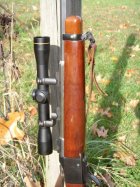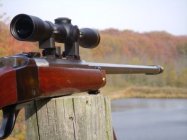Really appreciate the responses. Thought I would give it one more go and address a few of the responses.
As to what and how I shoot. Have almost never shot in competition and never plan to. Shoot off a bench generally @ 230 yds, 510 yds, 800 yds. Will shoot off hand occasionally (200-300 yds). On the bench use plain ole sand bags at the rear, and a very simple rest on the forearm. Offhand, I usually latch on to a tree trunk for support (semi-offhand?). Rarely shoot sitting. More often prone without bipod support, and maybe hasty use of sling.
GPat makes a good point about specifications. I however feel that a discussion with the maker is often helpful. Autocracy on either side of the equation is not really good. Did get a very nice unsolicited call once (he had to get my cell number from my wife at home), thanking me for providing Krieger with an Autocad drawing of the barrel I was after. Apparently this is rarely done and much appreciated when it is done. Kreiger did the inititial turn, and a riflesmith did the octagon contouring from there. GPat has a good point.
In the particular instance originating this discussion, I once again sent a CAD drawing, which interestingly was lost somewhere. Will get the barrel soon (it is way overdue as you might expect), and I well may like it better than my first go at designing the contour. The individual involved, after all, has extensive experience. I rather imagine at this point that I will in fact be satisfied. Allowing the barrel maker some creativity (as well as the riflesmith) often garners improvements over the original concept.
Let take another run at my notion of a "creedmoor" contour using some contemporary publications.
In David Tubb's book 'The Rifle Shooter' he is discussing barrels (p 328) and observes "Barrel contour is another area of change or evolution for me. . . . it is essentially the smallest diameter barrel that doesn't shoot any worse than the heaviest barrel." On the page is a diagram of a barrel showing where DT thins it out (saving about a pound), mainly in the middle sections of the barrel contour.
Keeping what we might call the "Tubb Critique" in mind, let turn to Dan Lilja's article "A Look at the Rigidity of Benchrest Barrels". It is well worth reading, even if a lot of it is over your head and you don't like looking at numbers in data tables. Some perhaps "offhand notions" are dispelled. Barrel rigidity increase with the "fourth power" of diameter. Increasing the diameter of a barrel a "little bit" doesn't increase the rigidity of the barrel "a little bit"; it increases the rigidity "a little bit" times "a little bit" times "a little bit" times "a little bit". A little increase in diameter improves the stiffness of a barrel a lot.
As barrel length increases rigidity decrease by the cube of the length. So a longer barrel is more "whippy". And a "bit" longer barrel is not a bit more whippy. It is "a bit" times "a bit" times "a bit" more whippy. Thus the commonly observed "short fat" benchrest barrel. But How do you optimize these two things?
In Lilja's computer calculations, he is surprised by high rigidity of a "hunter class" contour. Which Expiper noted above. Lilja also mentions the little XP-100 with their 14-15" tubes are surprising in their accuracy (due to their short length). One of Lilja illuminating observations from his calculations is that a full 1.25" diameter of the barrel for the first 5" inches from the breech causes a rather out of proportion improvement in rigidity.
So, what are we to make of the "Tubb Critique" and the "Lilja Critique" of barrel contour? Well, what I make of it is a synthesis called the "creedmoor" contour. It is a barrel that is rather heavy towards the breech, and rather light towards the muzzle, more or less. So what does this look like on a 24" barrel? Well I think it looks something like this, measured from the breech along the contour:
4-6" @ 1.25" diameter, followed by
4-6" @ a lesser diameter, followed by
12-16" of the least diameter.
Likely with fluting, or an octagon shape to reduce weight in the first 8-12 inches.
And with a very marked "step" between the 12-16" muzzle part of the barrel, and the breech end of the barrel.
This is exemplified historically by the "half octagon/half round" barrels seen at the Creedmoor matches of old. Potentially a generic contour with a lot of variation, depending what exactly you are going to use it for. Certainly not an autocratic contour.
This sort of contour is however not common, so it generates a concern among some that someone ordering such belongs to part of the lunatic fringe found on 6mmBR.com.
On the other hand one might expect that the culture at Lilja Barrels would not off-put by something like this at all. In fact they turn octagon contours. These are not set, as "they are all make per customer's request." And in fact that is my experience with them to this point. No "WHAT?"; took it all easily in stride, cashed my check, emailed a confirmation, and I should have a "creedmoor" contour, according to my notions anyway, in a few months. I just used one of their two octagon drawing files, changed the dimensions, set it to them, and that was it. Didn't even make a cad drawing.
So, everybody is a bit different. Wonder how that short three groove tube will toss those pills from a 30 BR on the little Bat action (SV)? We'll see.













